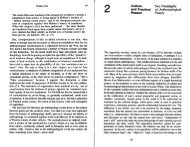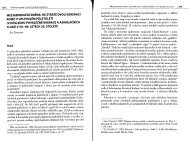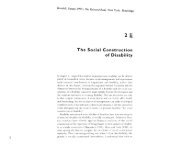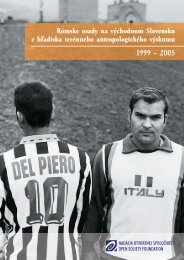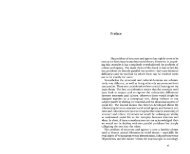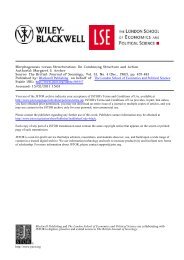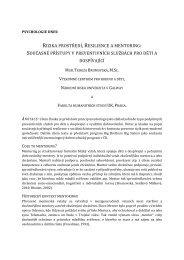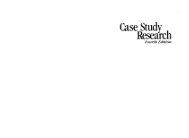Understanding Harry Potter: Parallels to the Deaf World - Moodle
Understanding Harry Potter: Parallels to the Deaf World - Moodle
Understanding Harry Potter: Parallels to the Deaf World - Moodle
You also want an ePaper? Increase the reach of your titles
YUMPU automatically turns print PDFs into web optimized ePapers that Google loves.
Endnotes 449<br />
We <strong>the</strong>refore need <strong>to</strong> be careful of <strong>the</strong> kind of<br />
taxonomy we use <strong>to</strong> organize our perceptions. Gould<br />
(1995) responded <strong>to</strong> this by offering a cautionary note:<br />
This propensity <strong>to</strong> tell s<strong>to</strong>ries grants us resolution,<br />
but also spells danger in avenues <strong>the</strong>reby opened<br />
for dis<strong>to</strong>rtion and misreading. For our favorite s<strong>to</strong>ries<br />
unroll along definite and limited pathways (we<br />
call <strong>the</strong>m epics, myths and sagas and <strong>the</strong>y show<br />
eerie similarities across disparate cultures) and<br />
we often try <strong>to</strong> channel a much more varied nature<br />
along <strong>the</strong>se familiar and edifying routes.<br />
We must remember that <strong>the</strong>se patterns can also<br />
dis<strong>to</strong>rt our views of reality, sometimes generating<br />
limited understanding of <strong>the</strong> complex nature of <strong>the</strong><br />
s<strong>to</strong>ries we tell.<br />
Surely, <strong>the</strong> Milan Conference was an abhorrent<br />
declaration of oppressive and audist attitudes. But<br />
was <strong>the</strong> time before <strong>the</strong> conference truly a golden<br />
age for <strong>Deaf</strong> people? Calling that time <strong>the</strong> golden<br />
age does not account for how <strong>the</strong> environment was<br />
so ready <strong>to</strong> accept drastically new attitudes about deaf<br />
people of all ages and <strong>the</strong>ir education. The point being,<br />
perhaps times were not so golden after all. As<br />
such, we need <strong>to</strong> be aware of <strong>the</strong> complex nature of<br />
<strong>the</strong> his<strong>to</strong>ry we may overlook because <strong>the</strong> pathways our<br />
characterizations must take do not always allow for<br />
diversions. Perhaps Robert Frost was even more insightful<br />
than we knew when he <strong>to</strong>ok <strong>the</strong> ‘‘road lesser<br />
traveled,’’ because it can make ‘‘all <strong>the</strong> difference.’’<br />
We may need <strong>to</strong> realize that true s<strong>to</strong>ries are not so<br />
easy <strong>to</strong> tell. Truth, as Dumbledore says, ‘‘is a beautiful<br />
and terrible thing, and should <strong>the</strong>refore be treated with<br />
great caution’’ (Rowling, 1997). True s<strong>to</strong>ries can be<br />
beautifully packaged in neat patterns such as <strong>the</strong> Edenic<br />
narrative or <strong>the</strong>y can be terribly cumbersome, ill suited<br />
<strong>to</strong> <strong>the</strong> diversions necessary for a comprehensive account.<br />
In any event, <strong>the</strong> way we tell s<strong>to</strong>ries exposes<br />
our ‘‘literary biases for narrative continuity’’ giving us<br />
‘‘<strong>the</strong> standard format for his<strong>to</strong>rical s<strong>to</strong>ries: purposeful,<br />
directional and sensible change’’ (Gould, 1995). This<br />
should not prevent us from enjoying our s<strong>to</strong>ries. In fact,<br />
if we approach our s<strong>to</strong>ries with critical, cautious awareness<br />
we can enjoy <strong>the</strong>m more deeply and thoroughly.<br />
We can, of course, appreciate <strong>the</strong> typical patterns<br />
we have come <strong>to</strong> know and love, patterns that may<br />
represent a uniquely human way of understanding<br />
our world. At <strong>the</strong> same time, we can also be better<br />
prepared <strong>to</strong> understand what we might miss as a result<br />
of being conditioned <strong>to</strong> package s<strong>to</strong>ries according <strong>to</strong><br />
traditional elements.<br />
Implications<br />
The parallels between <strong>Harry</strong> <strong>Potter</strong> and <strong>the</strong> <strong>Deaf</strong><br />
<strong>World</strong> are striking. Our attempts at organizing <strong>the</strong><br />
parallels have established an initial framework for<br />
analyzing literature using <strong>the</strong> insights and richness<br />
of <strong>the</strong> <strong>Deaf</strong> <strong>World</strong>. The <strong>Deaf</strong> Lens is a new and, <strong>to</strong><br />
this point, rarely considered perspective. Our work has<br />
<strong>the</strong>refore created an opportunity for <strong>the</strong> <strong>Deaf</strong> Lens we<br />
‘‘never knew was <strong>the</strong>re’’ <strong>to</strong> narrate within established<br />
s<strong>to</strong>ries. Interestingly, many scholars, Michel Foucault<br />
and Stephen Jay Gould among <strong>the</strong>m, have noted that<br />
exploring <strong>the</strong> features our taxonomies typically exclude<br />
are just as significant as those that we include. Reading<br />
narratives through <strong>the</strong> <strong>Deaf</strong> Lens will make significant<br />
contributions <strong>to</strong> our understanding of social arrangements,<br />
thus generating new ideas that transform our<br />
concepts of our world and ourselves.<br />
This in-depth analysis is also important because<br />
it contributes <strong>to</strong> promoting ASL and English literacy.<br />
We can show children and adults that <strong>the</strong>y have new<br />
ways <strong>to</strong> own s<strong>to</strong>ries while celebrating <strong>the</strong>ir life experiences.<br />
Approaching academic instruction in this way<br />
promotes critical thinking while confirming <strong>the</strong> experiences<br />
of deaf and hard-of-hearing children as real and<br />
valuable. If students witness <strong>the</strong> application that <strong>the</strong>ir<br />
lives have <strong>to</strong> literature and literature study, it provides<br />
greater incentive for reading and general academic performance.<br />
As Hirsch, Kett, and Trefil (2002) stated<br />
‘‘much of <strong>the</strong> art of teaching is associating what kids<br />
need <strong>to</strong> learn with what <strong>the</strong>y already know.’’ Taking<br />
advantage of <strong>the</strong>se associations will serve <strong>to</strong> enhance<br />
<strong>the</strong> quantity and quality of literature study by students<br />
and scholars alike.<br />
The potential that this opens up for development<br />
of materials (both ASL and English based) for many<br />
forms of ASL and English narratives is great. Imagine<br />
<strong>the</strong> insight <strong>Deaf</strong> children, young or old, can bring <strong>to</strong><br />
s<strong>to</strong>ries such as The Ugly Duckling, Pinocchio, and<br />
Frankenstein and <strong>the</strong> kinds of <strong>the</strong>me studies that could



